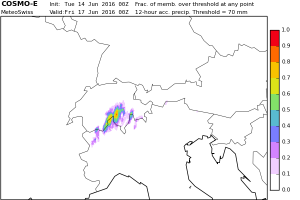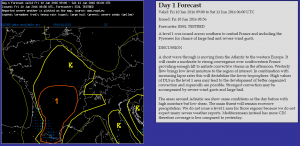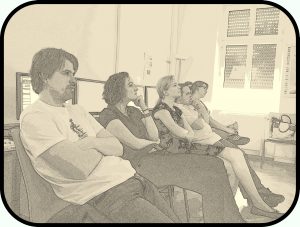Already on the first full Testbed day the situation is very interesting regarding low level moisture. We are assessing what role for example the EUMETSAT Nowcasting SAF total precipitable water (TPW) products can play in detecting local moisture differences:
ESSL Testbed 2017 ready to start
The ESSL Testbed 2017 welcomes all participants of this years’ edition.
We are proud to present you again an interesting selection of leading-edge forecasting and warning tools. New this year are for example a number of products from the EUMETSAT Nowcasting SAF.
 Pieter Groenemeijer and Tomas Pucik observing high precipitation storms at lunchtime in Wiener Neustadt on the day before the testbed starts.
Pieter Groenemeijer and Tomas Pucik observing high precipitation storms at lunchtime in Wiener Neustadt on the day before the testbed starts.
Focus for thunderstorms shifts to Spain
Today’s session began with the verification of yesterday’s outlook, which in general verified well. Both distributions of lightning activity but also of numerous severe weather reports were covered by the forecasters with lightning and level 1 areas respectively. The main discrepancy occurred over the far western Ukraine. A fast moving cold front was anticipated but instead, a line of storms evolved, which re-developed over the same area for a prolonged period of time. The reason for this development probably was the orientation of the front compared to the background flow. Over that area of interest, the front had more an east-west alignement and hence was placed nearly parallel to the background flow. Therefore flash flood producing rain was the main risk which was verified by a few reports. Yesterday’s nowcasting group indeed issued a watch area for excessive rain along that line of thunderstorms!
Thereafter once again Day 1 and 2 outlooks were prepared and two participants of both groups presented the results:
Especially the Day 1 group had a difficult task to forecast the activity over Spain, Portugal and Algeria. Thunderstorms were already ongoing, but a complex interaction of strong cap, rough orography, various outflow boundaries and numerous regions with showers/thunderstorms caused vivid discussions about where to place any level area. In addition, hand analysis was performed to get a better feeling about how good/bad models displayed the near real time environment.
Harold Brooks then had a talk about ingredients of soundings, where it became obvious that especially the forecast of severe wind gusts is rather difficult. However, the hail threat for example is dictated mainly by CAPE but also for a lesser degree by shear. Many more interesting results were presented.The other part of the presentation was about verification and evaluation, where very interesting questions were raised, how and why verifications are needed.
During the afternoon hours nowcasting was performed for SW Spain and Portugal, where stronger thunderstorms developed. The other group prepared Day 3 to 5 outlooks, which become increasingly more interesting regarding a more widespread risk for organized thunderstorms over parts of CNTRL Europe. Sadly this activity will occur beyond our testbed week.
Working in the field and the third day
On Tuesday, we had the chance to witness the development of a few thunderstorms next to Vienna Neustadt. During the nowcasting session it became obvious that numerous strong to severe thunderstorms would evolve over the mountains. They slowly moved off to the east/southeast and therefore passed just to the south of Vienna Neustadt. What could be better than verifying our forecast in real nature? Hence we took our cars and drove a few miles to the southwest of Vienna-Neustadt.
There was a lot of discussions which storm to take and if the large hail risk, which was forecast by the Day 1 group, would verify (important for those who took their own cars for chasing ). We finally intercepted a severe storm which produced large hail with more than 3 cm in diameter to our west (ESWD report), before weakening. Still a strong downpour of rain occurred. Also, a small funnel cloud was observed in the outflow of that thunderstorm (along the base of the upper most cumulus cloud).
In the end everyone was glad to see that forecast multicell convection verified.
Today on Wednesday, once again Day 1 and 2 outlooks were prepared by different groups. It already became obvious that the participants learned a lot as there were vivid discussions about the ingredients and where to place the lightning and level areas. Especially the group with the Day 1 forecast had a very complex pattern with various places to look at. However the Day 2 group also spent a lot of time in preparing the outlook for Spain (questions like the following one had to be answered: will the cap break, which model has the best handling on shear and instability and so on). In the end, both groups issued numerous level 1 areas and we’re already looking forward how they verify. In the following image, Mr. Herold presented the Day 1 forecast.
We’re now starting the nowcasting session and we prepare the Day 3 to 5 outlooks. Let’s see what happens in that time frame …
Preparing the first outlooks
On the second day of the final Testbed week, the participants worked on their first outlooks. During the morning/forenoon hours the outlooks of the Day1 and 2 periods were prepared. Overall, the best chance for severe storms was confined to the Alps and Poland for Day 1 due to the approach of a cold front from the west. Moderate shear/CAPE caused two level 1 areas. A similar result became visible for Day 2 with two level 1 areas displaced more to the south and southeast. Overall, participants tried to get a feeling about how to use the ingredient-forecasting method.
Afterwards a very interesting talk about lightning detection products was offered by Kathrin Wapler, including numerous case studies and statistics about various thunderstorm events. Within this talk remote sensing data was included like satellite and radar data but also reports from ESWD. So called lightning jumps (a sudden increase in lightning activity) often preceeds severe weather reports which could be useful for thunderstorm forecasts.
Finally during the afternoon hours, two groups used the afternoon hours to either prepare nowcast warnings or to work on Day 3-5 forecasts. In general no outbreak of severe thunderstorms is forecast. Nevertheless numerous regions of interest exist like over Spain and the Balearic Islands.
Start of the last testbed week
This week will be the last week for the testbed. A new group of participants have arrived in Wiener Neustadt and are looking forward to learning new techniques and working with new tools during this Testbed week.
On the first day, the participants listened to talks about convective storm types and ingredient based forecasting. After those talks it was time to get familiar with the testbed models and nowcast interface. The participants explored these aspects by doing a small exercise on a past situation, where numerous storms formed over parts of western- and central Europe. By analyzing these storms using nowcast and model data, participants got the opportunity to use all the tools available during the testbed, which they will be using the rest of the week to make forecasts.
Striking COSMO-E signal for 70 hour forecast
COSMO-E predicts a very high probability for extreme precip amounts in the Valais and Ticino area of southern Switzerland for Thursday late evening.
Maximum projection of all ensemble members showing maximum 12 h precip sums of locally more than 200 mm.
Point by point probability for rain sums larger than 70 mm: around 80 % in some places.
Fraction of members exceeding the threshold of 70 mm in a 40 by 40 km square. Nearly all members for this timestep predict excessive rainfall in south-central Switzerland.
High impact weather phase about to start
ESSL Testbed severe weather briefing for the upcoming days with public online access via fmi.sabameeting.com starting at 09:00 UTC. Presenters today: Tomas Pucik and Pieter Groenemeijer
End of the first successful testbed week
On the last day of the testbed we again started with the verification of the last day, followed by an outlook for Day1 and Day2.
The participants of the group that forecasted the Day1 outlook decided two choose the western domain at least for two main reasons. A sharp short wave trough passing France during the day looks by far more dynamic than the storms that will for sure fire up over parts of Italy and the Balkan Peninsula. And second: The European Championship will start this evening in Paris.
Downstream of an amplified short wave trough, southwesterly flow led to an advection of warm airmasses into France. Initially a lack of low level humidity was found due to the foehn winds from the Pyrenees. But corresponding to the short wave trough also a maximum of humidity is advected into Southern and Southwestern France later on. This will partly overlap with higher lapse rates downstream. That raises the possibility for at least a few hundred J/kg of CAPE. Lift is provided both by the approaching short wave trough and a well-defined surface convergence zone, respectively.
What brought us to the decision of issuing a LVL1 for the area of interest was the overlap of a high likeliness of storms and DLS values of 15 to 20 m/s.
During the night this risk diminishes due to the diurnal cycle as well as a reduction of the amplitude of the trough not staying as pronounced as before.
The second group decided to choose the eastern domain which already is and will be influenced also on Day2 by a strong trough with a corresponding surface low. The highest values of BL moisture can be found in a narrow band along the cold front. Having lapse rates between 6 to 6.5 K/km the combination with humidity is forecasted to result in a few hundreds of J/kg of MLCAPE. At the same time DLS is predicted to be very high with up to 30 m/s. However, initiation is a bit questionable but wherever storms may fire up they have an enhanced threat for severe weather.
After forecasting and the online presentation of the results the testbed groups had another evaluation of the products. As an example we were looking on a case of 27th of May concerning storms over Southern Germany at 16 UTC. It is visible that several products really gave a good hint for severe weather that finally was reported with the large hail events that are visible in the images.
It is Friday and so the first testbed week ends. All participants were leaving us happy and satisfied and we had a great time with really enthusiastic participants. Having a look to the upcoming testbed week it seems that a high-end weather situation will be present especially during the second half of the week. So… really looking forward.
























